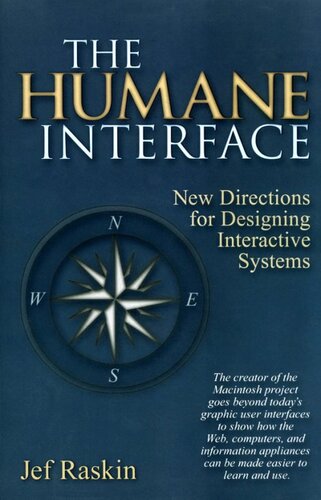The Humane InterfaceNew Directions for Designing Interactive Systems
|

|
 Diese Seite wurde seit 1 Jahr inhaltlich nicht mehr aktualisiert.
Unter Umständen ist sie nicht mehr aktuell.
Diese Seite wurde seit 1 Jahr inhaltlich nicht mehr aktualisiert.
Unter Umständen ist sie nicht mehr aktuell.
 Empfehlungen
Empfehlungen
 Deep thinking is rare in this field where most companies are glad to copy designs that were great back in the 1970s. The Humane Interface is a gourmet dish from a master chef. Five mice!"
Deep thinking is rare in this field where most companies are glad to copy designs that were great back in the 1970s. The Humane Interface is a gourmet dish from a master chef. Five mice!" Zusammenfassungen
Zusammenfassungen
 This unique guide to interactive system design reflects the experience and vision of Jef Raskin, the creator of the Apple Macintosh project. Other books may show how to use today's widgets and interface ideas effectively. Raskin, however, demonstrates that many current interface paradigms are dead ends, and that to make computers significantly easier to use requires new approaches. He explains how to effect desperately needed changes, offering a wealth of innovative and specific interface ideas for software designers, developers, and product managers. The Apple Macintosh helped to introduce a previous revolution in computer interface design, drawing on the best available technology to establish many of the interface techniques and methods now universal in the computer industry. With this book, Raskin proves again both his farsightedness and his practicality. He also demonstrates how design ideas must be built on a scientific basis, presenting just enough cognitive psychology to link the interface of the future to the experimental evidence and to show why that interface will work. Raskin observes that our honeymoon with digital technology is over: We are tired of having to learn huge, arcane programs to do even the simplest of tasks; we have had our fill of crashing computers; and we are fatigued by the continual pressure to upgrade. The Humane Interface delivers a way for computers, information appliances, and other technology-driven products to continue to advance in power and expand their range of applicability, while becoming free of the hassles and obscurities that plague present products.
This unique guide to interactive system design reflects the experience and vision of Jef Raskin, the creator of the Apple Macintosh project. Other books may show how to use today's widgets and interface ideas effectively. Raskin, however, demonstrates that many current interface paradigms are dead ends, and that to make computers significantly easier to use requires new approaches. He explains how to effect desperately needed changes, offering a wealth of innovative and specific interface ideas for software designers, developers, and product managers. The Apple Macintosh helped to introduce a previous revolution in computer interface design, drawing on the best available technology to establish many of the interface techniques and methods now universal in the computer industry. With this book, Raskin proves again both his farsightedness and his practicality. He also demonstrates how design ideas must be built on a scientific basis, presenting just enough cognitive psychology to link the interface of the future to the experimental evidence and to show why that interface will work. Raskin observes that our honeymoon with digital technology is over: We are tired of having to learn huge, arcane programs to do even the simplest of tasks; we have had our fill of crashing computers; and we are fatigued by the continual pressure to upgrade. The Humane Interface delivers a way for computers, information appliances, and other technology-driven products to continue to advance in power and expand their range of applicability, while becoming free of the hassles and obscurities that plague present products. Dieses Buch erwähnt ...
Dieses Buch erwähnt ...
 Personen KB IB clear | Susan Lammers , Brenda Laurel , George Miller , Jakob Nielsen , Donald A. Norman , Roger Penrose , Claude Shannon , Ben Shneiderman , Edward R. Tufte , Warren Weaver | ||||||||||||||||||||||||||||||||||||||||||||||||||||||||||||||||||||||||||||||||||||||||||
 Begriffe KB IB clear | HCI/MMI (Human-Computer-Interaction)Human-Computer-Interaction | ||||||||||||||||||||||||||||||||||||||||||||||||||||||||||||||||||||||||||||||||||||||||||
 Bücher |
| ||||||||||||||||||||||||||||||||||||||||||||||||||||||||||||||||||||||||||||||||||||||||||
 Texte |
|
 Zitationsgraph
Zitationsgraph
 Zitationsgraph (Beta-Test mit vis.js)
Zitationsgraph (Beta-Test mit vis.js)
 Zeitleiste
Zeitleiste
 7 Erwähnungen
7 Erwähnungen 
- Universal Principles of Design - A Cross-Disciplinary Reference (William Lidwell, Kritian Holden, Jill Butler) (2003)


- Theory of Computation as a Vehicle for Teaching Fundamental Concepts of Computer Science - Thesis 15035, ETH Zürich, D-INFK, May 2003 (Raimond Reichert) (2003)



- Emotional Design - Why we love (or hate) everyday things (Donald A. Norman) (2004)


- Wissensprojekte - Gemeinschaftliches Lernen aus didaktischer, softwaretechnischer und organisatorischer Sicht (Bernd Pape, Detlev Krause, Horst Oberquelle) (2004)

- Benutzergerechte Gestaltung von CSCL-Systemen (Matthias Finck, Michael Janneck, Horst Oberquelle)
- i-com 2/2004 (2004)
- Gebrauchstaugliche Gestaltung von E-Learning-Systemen (Matthias Finck, Michael Janneck, Horst Oberquelle)

- Gebrauchstaugliche Gestaltung von E-Learning-Systemen (Matthias Finck, Michael Janneck, Horst Oberquelle)
- Linking Physical and Virtual Worlds with Visual Markers and Handheld Devices - Dissertation, Eidgenössische Technische Hochschule ETH Zürich, Nr. 16193 (Michael Rohs) (2005)


- Tablets in Schule und Unterricht - Forschungsmethoden und -perspektiven zum Einsatz digitaler Medien (Jasmin Bastian, Stefan Aufenanger) (2017)

 Co-zitierte Bücher
Co-zitierte Bücher


Unterrichtsplanung
(Wolfgang Schulz) (1980)
Strömungen, Leitbilder und Begrifflichkeit der Software-Ergonomie
Habilitationsschrift
(Susanne Maass) (1994)
The Inmates are Running the Asylum
Why High-Tech Products Drive Us Crazy and How to Restore the Sanity
(Alan Cooper) (2002)

 Volltext dieses Dokuments
Volltext dieses Dokuments
 Standorte
Standorte 
 Bibliographisches
Bibliographisches 
 Beat und dieses Buch
Beat und dieses Buch
Beat war Co-Leiter des ICT-Kompetenzzentrums TOP während er dieses Buch ins Biblionetz aufgenommen hat. Die bisher letzte Bearbeitung erfolgte während seiner Zeit am Institut für Medien und Schule. Beat besitzt ein physisches und ein digitales Exemplar. (das er aber aus Urheberrechtsgründen nicht einfach weitergeben darf). Es gibt bisher nur wenige Objekte im Biblionetz, die dieses Werk zitieren.


























 Biblionetz-History
Biblionetz-History